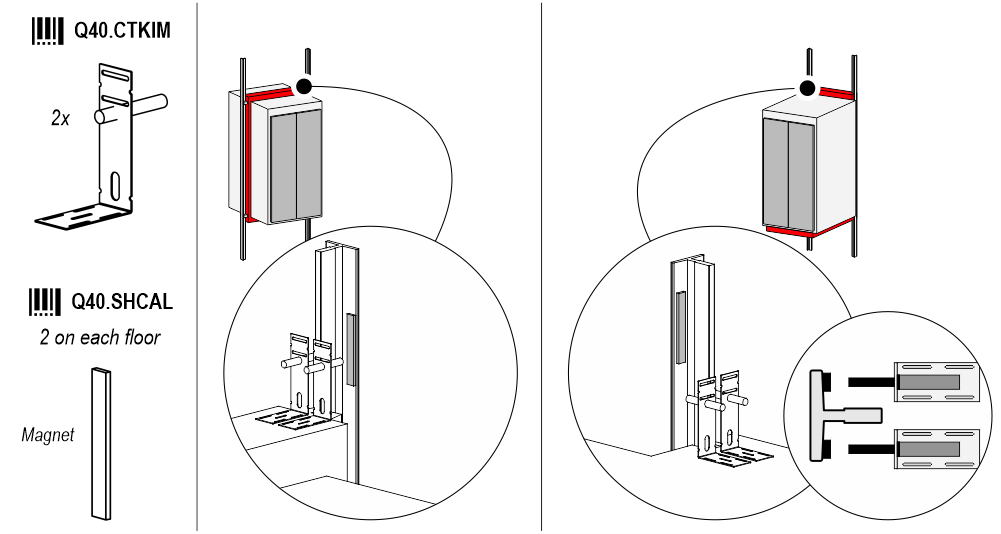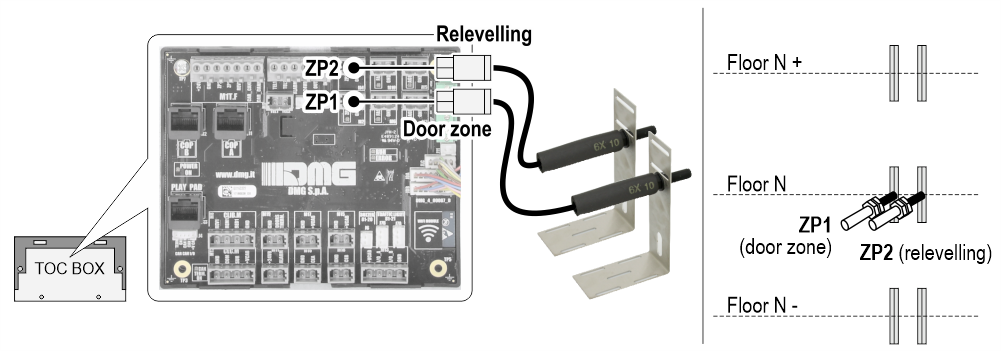The Pitagora 4.0 system manages two specific functions that require a maneuver with the doors open:
- Relevelling function
- Advance door opening function
Both functions require the presence of a dedicated safety circuit inside the controller (Q40.FNRLV – Open door safety circuit). The same circuit can serve both functions if they are present at the same time.
The circuit works similarly to the Door Zone (ZP) function.
The Releveling function is mandatory for hydraulic systems and optional for traction lifts. It becomes mandatory also for traction lifts when, by design, it is not possible to guarantee an extension of the cables such that they always remain within the floor alignment limits required by the EN81.20 standard (+/-20 mm from the floor threshold).
The Advance Opening function allows the start of door opening to be anticipated with respect to the moment of arrival at the floor (drop of the travel contactors), and is considered an optional for fast and/or high-end systems.
Both functions require an Incremental Positioning System or an Absolute Positioning System for their correct operation (the traditional magnetic reader positioning system is not indicated). Only in the case of hydraulic systems is it possible to match the Releveling function with the magnet reader system.
Installation instructions
Both functions require the installation in the shaft of the RZPA magnetic reader and magnets for each landing. The 3m cable of the magnetic reader must be plugged into the ZP2 input on the TOC box:


See the Quick Installation Guide for more details.
Setup and use
Relevelling
The Releveling function consists in the activation of a realignment maneuver of the cabin at the landing level, performed at low speed and with the doors open, aimed at compensating for any misalignment (gap) between the landing threshold and the cabin threshold when the cabin stops at floor.
The Pitagora 4.0 controller offers three types of Releveling maneuvers, which differ from each other in the start tolerance of the maneuver itself with respect to the stop level at the floor defined in the self-learning maneuver phase:
- Type 1: start tolerance of the maneuver +/- 10mm. This selection is more indicated for traction VVVF lifts to guarantee full compliance to EN81.20 code as long as the stopping accuracy is concerned.
- Type 20: start tolerance +/- 20mm. This selection is best suited for hydraulic elevators as it allows for greater tolerance in the floor stopping accuracy.
- Type 10+20: start tolerance +/- 20mm with cabin with closed doors and +/-10mm with cabin with open doors. This solution is a combination of the previous two and is recommended for hydraulic lifts to avoid too frequent relevelling maneuvers by providing greater tolerance when the cabin doors are closed (and thus possibly empty).
Use the Parameter A8 – Relevelling in the Configuration Menu to enable the function with the desired selection
Advance opening
The Advance Opening function consists in activating the door opening signal before the actual stop at the cabin floor (and therefore before the travel contactors are deactivated), within a well-defined arrival area which is similar to (or coinciding with) the door area.
Use the Parameter B18 – Advance opening in the Doors Menu to enable the function.
Impacts of open-door operations on the installation
Both functions are considered open-door operations and must be managed safely and under certain conditions.
First, the control panel must contain an appropriate safety device dedicated to the function. A single device is sufficient even if the two functions coexist.
Second, since an open-door operation involves the risk of uncontrolled movement of the cabin, a UCMP protection circuit must be present in the system.
The detection of a possible problem in monitoring the operation of the safety module for open door operations causes the ISO blocking error, which requires a specific reset procedure.

